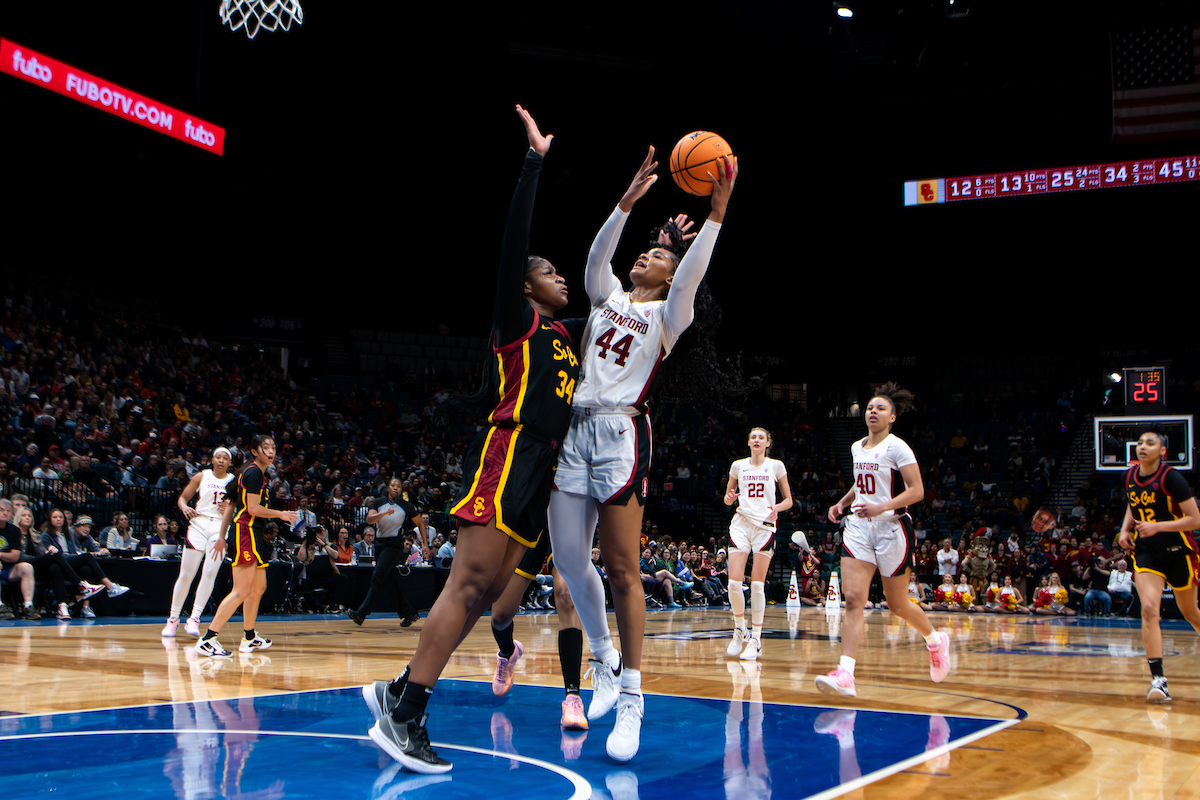Over this past weekend, the Stanford women’s basketball team (28-5, 15-3 Pac-12) made a run to the Pac-12 tournament final, ultimately losing to the No. 2 seed USC Trojans 74-61. But more important than the final result, the game showcased two contrasting styles of basketball: one rooted in tradition and one rooted in the modern game.
The first offensive possession from each team demonstrated this point. After the Trojans won the tip, the team utilized off-ball movement and a spread ball-screen to get their star JuJu Watkins going downhill toward the basket. Watkins’s gravity drew the weak side defender down to the paint, and the freshman kicked the ball out to McKenzie Forbes, who drilled a 3-pointer.
Once Stanford got the ball back, it ran the point series from the Princeton offense, with Kiki Iriafen getting the ball in the high post and Hannah Jump setting a pin-down screen on the strong side for Elena Bosgana. The ball eventually got reversed to Cameron Brink, who knocked down a 3-pointer from the perimeter to tie the game.
However, the Cardinal weren’t able to convert enough of their shot attempts, shooting just 42% from the floor en route to their loss.
“We have to execute offensively better,” said Stanford head coach Tara VanDerveer after the game. “We didn’t always get the shots that we wanted.”
After the game, a number of Stanford fans expressed concern about the team’s offensive performance, hoping VanDerveer would institute sweeping changes before the NCAA tournament. But this concern isn’t just limited to Cardinal fans. Many who watch women’s college basketball would probably say that Stanford’s offense doesn’t seem as pretty as those of its counterparts at the top of the sport. This is because Stanford appears to be more dependent on post-ups and face-ups to manufacture points, rather than relying on precise shooting like other teams.
While analytics have demonstrated that basketball is played most efficiently with a high volume of 3s, layups and free throws, this isn’t something that can be implemented by a simple scheme change. To play a more “modern” version of basketball requires lead guards who are proficient at shooting off the dribble and driving to the basket, as well as off-ball players who can shoot off the catch.
The Cardinal do have numerous players who fit the second condition, but they lack a dynamic lead guard that can consistently make teams pay off ball screens beyond the 3-point line. There isn’t a guard akin to Caitlin Clark, JuJu Watkins or Hannah Hidalgo on the roster — or any guard with sufficient gravity to attract help defenders and force opponents into defensive rotation consistently.
But what Stanford does have are two of the best post players in the country: Cameron Brink and Kiki Iriafen. Both players are adept in the post and have honed their skills to score in face-up situations.
VanDerveer’s Princeton offense allows the Cardinal to play through Iriafen and Brink in the high post, a strategy I find optimal since they are Stanford’s best players. Moreover, the player movement within the offense has created the space for Brink and Iriafen to get clean post-up and face-up opportunities.
So while I understand the fans who are clamoring for a revamped offense, you have to play through your best players. The current offense fits well with the team’s strengths and maximizes the talents of its best players.
Stanford also knows the shot profile it should have given its personnel. The Cardinal rank only 108th in the country in 3-point attempts, electing to take a higher percentage of their shots within the paint.
On Sunday, I often saw that the Cardinal were missing shots that they normally make, which I think helped warp the perception that the offense needs dramatic changes. However, I think changes need to be made only at the margins.
Certainly, Coach VanDerveer will emphasize to her players the importance of navigating physical play and how to approach facing more athletic opponents — problems that have plagued the team this season. But don’t expect wholesale scheme changes this late into the year. Instead, focusing on executing the current system will give the Cardinal the best chance at making another Final Four run.
